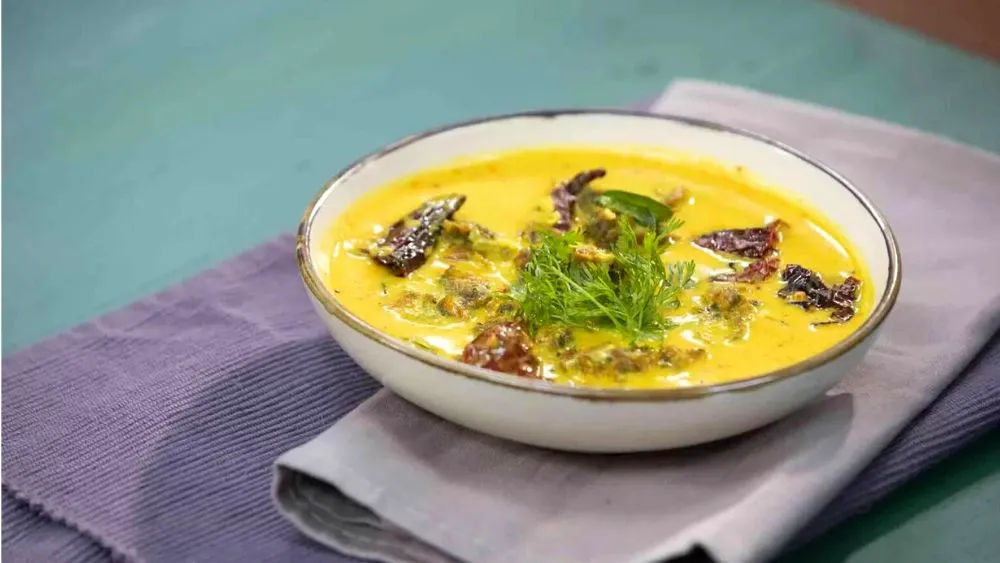
Kadi Pakoda Recipe

40 min

2-3 People

15 min
Introduction:
Ah, the emotional rollercoaster of Indian cuisine! For us, food isn't just sustenance; it's a journey through memories and emotions. Take Kadi Pakoda, for instance. Whenever I think of this dish, I'm instantly transported back to lazy Sundays at home, eagerly awaiting my mother's rendition of this classic recipe. There's something about the way she used to make it - the perfect balance of flavors, the warmth in every bite - that no restaurant could ever replicate. It's like a warm hug on a plate, a taste of home that's etched in my heart forever.
Kadi Pakoda is more than just a dish; it's a symbol of love, comfort, and tradition. Every household has its own version, each with its own unique twist and story behind it. But no matter how it's made, one thing remains constant - the joy it brings to the table and the memories it creates with every spoonful.
Recipe of Kadi Pakoda
Ingredients:
For Kadi:
- 1 bowl curd
- Salt to taste
- 1 tsp Turmeric
- 3 tsp Gram flour
- 1/2 tsp Red Chilli powder
- 1 tsp Ginger-Garlic paste
- Oil
- 1 pinch of Cumin
- 1 pinch Coriander seeds
- 2 tsp Chopped Garlic
- 1 cup chopped Onions
- 2-3 dried red Chilli
- Handful Curry leaves
- 1 tsp Asafoetida
For Pakoras:
- Chopped Spinach
- Chopped Onions
- Salt to taste
- Chilli powder
- Gram flour
Final Tempering:
- 2 tsp Ghee
- Handful Mustard seeds
- 2 dried red Chilli
- 2 slit Green Chilli
- Handful Curry leaves
- 1 tsp Asafoetida
- 1/2 tsp Red Chilli powder
Method:
-
Preparation:
- Dilute 1 bowl of curd with a little water and whisk it.
- Add salt, turmeric, gram flour, and red chili powder to the diluted curd. Whisk well.
- Mix in ginger-garlic paste and a little water. The mixture should be watery.
-
Cooking the Kadi:
- Heat oil in a pot. Add cumin seeds, coriander seeds, chopped garlic, chopped onions, and dried red chilies. Sauté.
- Add curry leaves and asafoetida. Stir.
- Pour in the curd mixture. Stir continuously and cover with a lid. Let it cook on low heat.
-
Preparing Pakoras:
- In a bowl, mix chopped spinach, chopped onions, salt, chili powder, and gram flour. Add water to make a thick paste.
- Deep fry small balls of this paste until golden brown. These are your Pakoras.
-
Final Tempering:
- In another pan, heat ghee. Add mustard seeds, dried red chilies, slit green chilies, curry leaves, asafoetida, and red chili powder. Let it cook.
-
Assembling:
- Pour the tempering over the cooked Kadi.
- Add the Pakoras into the Kadi.
- Turn off the flame and serve hot in a bowl.
Enjoy the flavorful and comforting Kadi Pakoda with rice or chapati!
About the Recipe:
Kadi Pakoda is a quintessential North Indian dish that combines chickpea flour (besan) dumplings with a tangy yogurt-based gravy. It's a comforting and hearty dish that's perfect for any occasion, whether it's a lazy weekend at home or a festive celebration with loved ones. The crispy pakoras soaked in the creamy, spiced gravy create a symphony of flavors that dance on your palate with every bite.
Cooking Tips:
- Ensure that the besan batter for the pakoras is thick enough to coat the back of a spoon but not too thick to make the pakoras dense.
- Fry the pakoras in batches over medium heat to ensure even cooking and crispiness.
- For a smoother gravy, whisk the yogurt well before adding it to the kadhi mixture to prevent lumps.
- Tempering (tadka) with mustard seeds, cumin seeds, curry leaves, and dried red chilies adds an extra layer of flavor to the dish.
- Let the kadhi simmer on low heat after adding the pakoras to allow them to soak up the flavors of the gravy.
Pairing Guide:
Kadi Pakoda pairs wonderfully with steamed rice or jeera rice for a wholesome meal. You can also serve it with hot rotis or parathas for a delightful combination. To balance out the richness of the dish, pair it with a side of fresh cucumber-tomato salad or pickled onions. For a complete feast, serve it alongside papadums and a dollop of mango pickle.
Frequently Asked Questions about Kadi Pakoda:
-
Can I make Kadi Pakoda without onions and garlic?
- Yes, you can skip onions and garlic in the recipe and still achieve a delicious Kadi Pakoda by adding extra flavor with spices like asafoetida (hing), ginger, and green chilies.
-
How do I prevent the yogurt from curdling in the kadhi?
- To prevent curdling, ensure that the yogurt is at room temperature before adding it to the kadhi mixture. Also, whisk the yogurt well and add it slowly while stirring continuously.
-
Can I make the pakoras in advance and add them to the kadhi later?
- Yes, you can fry the pakoras in advance and store them in an airtight container. Add them to the kadhi just before serving to maintain their crispiness.
-
Is Kadi Pakoda gluten-free?
- Yes, Kadi Pakoda can be made gluten-free by using gluten-free chickpea flour (besan) for making the pakoras and ensuring that all other ingredients are gluten-free.
-
Can I use vegetables instead of pakoras in Kadi Pakoda?
- Yes, you can add vegetables like potatoes, cauliflower, or spinach instead of pakoras to make a variation of Kadi Pakoda known as "Kadhi Pakora with Vegetables."
-
What is the difference between Kadi Pakoda and Kadi Chawal?
- Kadi Pakoda is a dish where besan dumplings (pakoras) are cooked in a yogurt-based gravy, while Kadi Chawal is simply the yogurt-based gravy served with rice, without the addition of pakoras.
-
Can I use sour yogurt for making Kadi Pakoda?
- It's better to use fresh yogurt for making Kadi Pakoda to ensure a balanced flavor. However, if you prefer a slightly tangy taste, you can use slightly sour yogurt.
-
How do I reheat leftover Kadi Pakoda?
- Reheat leftover Kadi Pakoda gently on the stovetop over low heat, stirring occasionally to prevent sticking. You may need to add a splash of water to adjust the consistency.
-
Can I make Kadi Pakoda without frying the pakoras?
- While traditionally, pakoras are fried before adding them to the kadhi, you can try baking them in the oven for a healthier version. However, the texture may differ slightly.
-
Is Kadi Pakoda a spicy dish?
- The level of spiciness in Kadi Pakoda can be adjusted according to personal preference by controlling the amount of green chilies and red chili powder used in the recipe.
